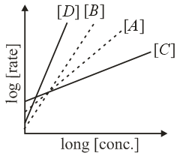EASY
Earn 100
The conversion of molecule to follow second order kinetics. If concentration of isincreased to three times. How will it effect the rate of formation of
(a)Rate increase by times
(b)Rate increase by times
(c)Rate increase by times
(d)Rate decrease by times
50% studentsanswered this correctly
Important Questions on Chemical Kinetics
MEDIUM

where,

and , are respectively, the rate constants for substitution and elimination, and , the correct option is ________
EASY
The initial concentration of is and it is after 30 minutes. The rate of formation of is:
EASY
EASY
Consider the following reactions
The order of the above reactions are respectively. The following graph is obtained when log[rate] vs.log[conc.] are plotted:

Among the following, the correct sequence for the order of the reactions is :
MEDIUM
(i)
(ii)
(iii)
The overall order of the reaction will be
HARD
The results given in the below table were obtained during kinetic studies of the following reaction:
| Experiment | Initial rate/ | ||
| I | |||
| II | |||
| III | |||
| IV | X | ||
| V | Y |
X and Y in the given table are respectively :
MEDIUM
In the following reaction;
‘A’ and ‘B’ respectively can be:
MEDIUM
EASY
If the concentration of is increased from , keeping the value of at , the rate constant will be:
HARD
...(i)
...(ii)
The closest rate constant for the overall reaction
is:
MEDIUM
EASY
Rate
If the concentration of A is kept the same but that of B is doubled what will happen to the rate itself?
EASY
Which of the following expression is correct for the rate of reaction given below ?
MEDIUM
MEDIUM
EASY
EASY
HARD
| Experiment No. | Rate of reaction | |||
The rate of the reaction for and is found to be The value of is __________
MEDIUM
HARD
For an elementary chemical reaction, , the expression for is:

